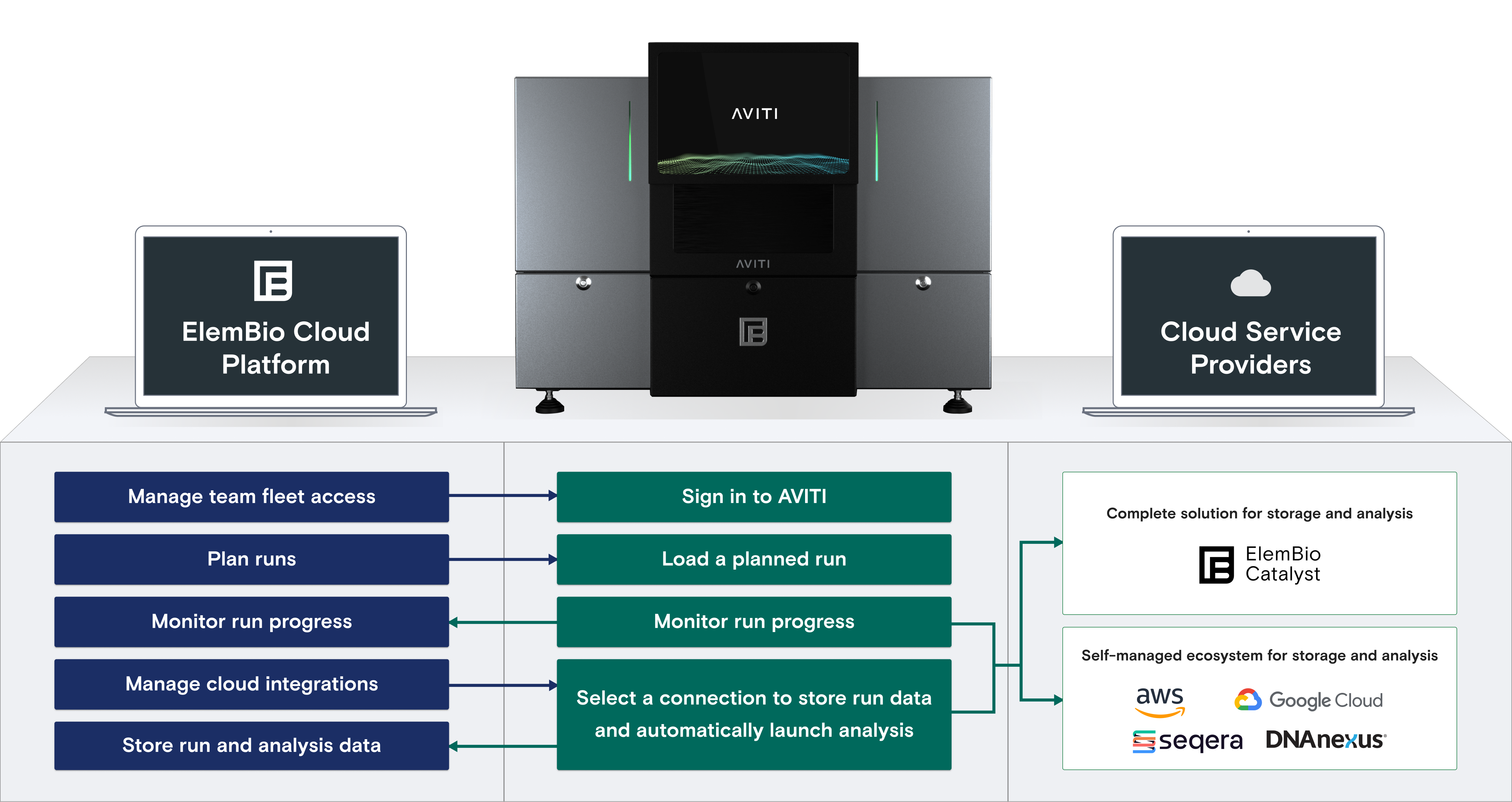Getting Started
ElemBio™ Cloud is a central online platform that provides real-time remote run monitoring and management for Element AVITI™ Systems. Any system in online mode automatically connects to the platform. To support your organization from anywhere, you can access ElemBio Cloud on a computer or mobile device.
ElemBio Cloud enables the following off-instrument tasks:
- Create and manage sequencing and cytoprofiling planned runs that you can load onto connected AVITI and AVITI24 Systems.
- Track the status and metrics of runs in real time.
- Design custom content for cytoprofiling runs with Custom Designer.
- Set up data analysis solutions on Elembio Cloud, including:
- Connect cloud storage to stream AVITI run data to the cloud.
- Configure cloud-based compute and flows for assignment and secondary analysis workflows.
- Manage access through team members and roles.
- Review the availability of add-on features for your organization.

ElemBio Catalyst™
ElemBio Catalyst is a subscription-based native cloud analysis solution, within ElemBio Cloud, that stores and analyzes AVITI data. ElemBio Catalyst provides Amazon S3 storage buckets for storage connections that Element manages on your behalf.
For sequencing, Element sets up a customizable Bases2Fastq flow and automatically generates a FASTQ file when a run completes.
For cytoprofiling, Element sets up a customizable Cells2Stats flow and automatically generates a visualization file when a run completes, which allows you to load a cytoprofiling run into CytoCanvas.
ElemBio Catalyst also supports highly accurate and efficient secondary analysis workflows for whole genome sequencing and enrichment panel applications as a premium subscription. Premium workflows are only available on ElemBio Catalyst.
For a complete list of assignment and secondary analysis workflows and available providers, see the Workflow Library.
Accessing ElemBio Cloud
The following web browsers support the latest version of ElemBio Cloud:
- Chrome (recommended)
- Firefox
ElemBio Cloud uses organization-specific URLs that follow the format https://{organization-id}.elembio.io. For example, https://example-lab.elembio.io. If you do not know your organization ID, contact Element Technical Support.
Access ElemBio Cloud without an Organization URL
To access ElemBio Cloud without your organization-specific URL, complete the following steps:
- Go to https://www.elembio.io.
- Select Login.
- Enter the name of your organization.
- Select Continue.
- Access ElemBio Cloud as applicable:
- For organizations with single sign-on (SSO), complete the prompts from the SSO service.
- For organizations without SSO, enter your credentials, and then select Continue.
Access an Example Organization
To preview the platform before receiving access, you can log in to an example ElemBio Cloud organization as a read‥only user.
- Go to https://qualityreadsinc.elembio.io.
- Select Login.
- Enter the email address demo@example.com
- Enter the password DemoUser!
- Select Continue.
Platform Navigation
The ElemBio Cloud navigation menu displays user information and the navigation icons listed in the following table. An open navigation menu displays the names of each section and includes arrow icons to expand and minimize links to additional pages.
| Icon | Name | Function |
|---|---|---|
| Hamburger menu | Open and close the navigation menu. | |
| Runs | Manage active, planned, and historical runs. | |
| Data Explorer | Access and manage files from runs and flows. | |
| Integrations | View, verify, and manage providers and connections. | |
| Analysis | View and manage flows and executions. | |
| Organization | View and manage team members and review add-on features. | |
| Support | Access documentation and download software for offline instruments. | |
| Logout | Sign out of ElemBio Cloud. |
Feature Cards
ElemBio Cloud displays cards for each occurrence or configuration of a feature for an organization, including providers, storage connections, compute connections, add-ons, and flows. Each card shows the feature name, details, and timestamps for related activities.
Icons on the cards show associated products, and badges indicate the status of the feature. Buttons allow you to complete actions, including a More button that displays a list of additional actions.
Troubleshooting
Reset a Password
The following instructions are for organizations that do not use an SSO identity provider (IDP). If you use an SSO IDP, consult your SSO administrator to troubleshoot credential problems.
- In a web browser, enter the ElemBio Cloud URL for your organization.
- Select Login.
- Select Forgot password.
- Enter your email address.
- Select Continue to send a password reset email.
- In the email, select Confirm.
The Change Your Password page appears.
- Enter and reenter a new password.
The password must contain at least eight characters and three of the following four character types: lowercase letters, uppercase letters, numbers, and special characters.
- Select Reset password.
- Select Back to ElemBio Cloud, and then sign in with the new password.